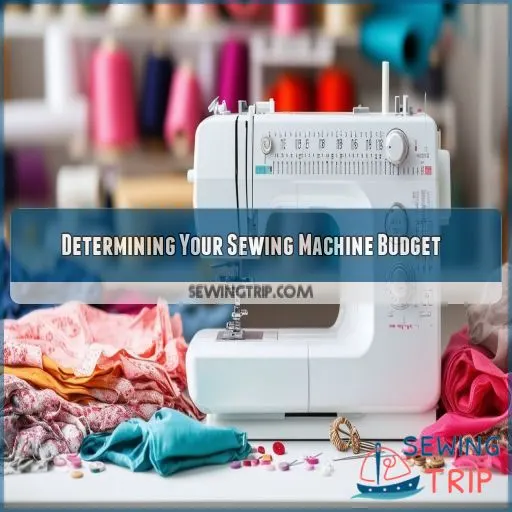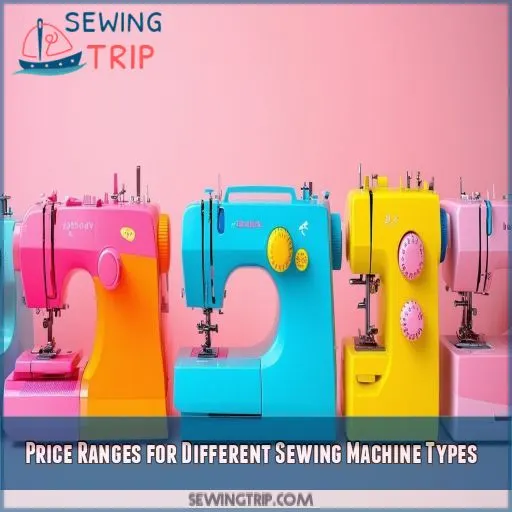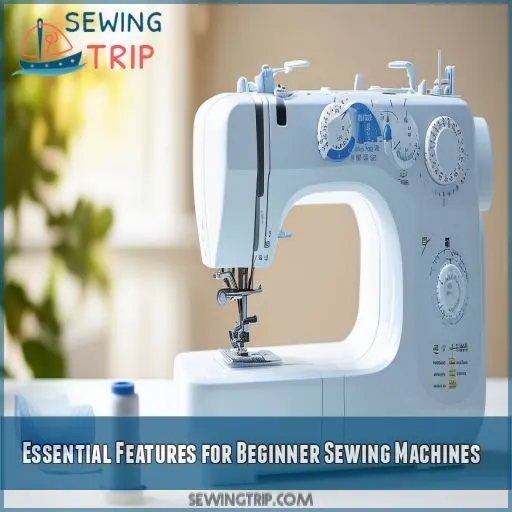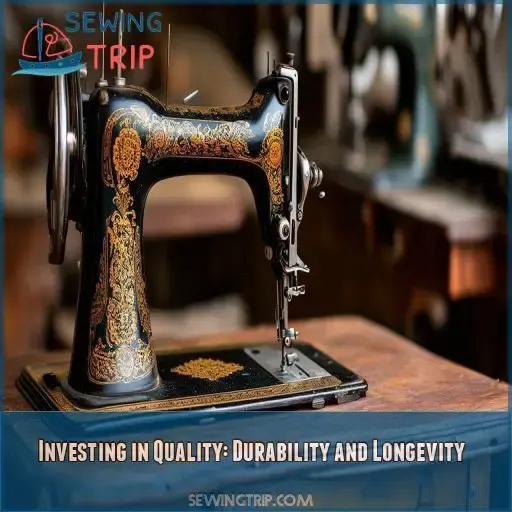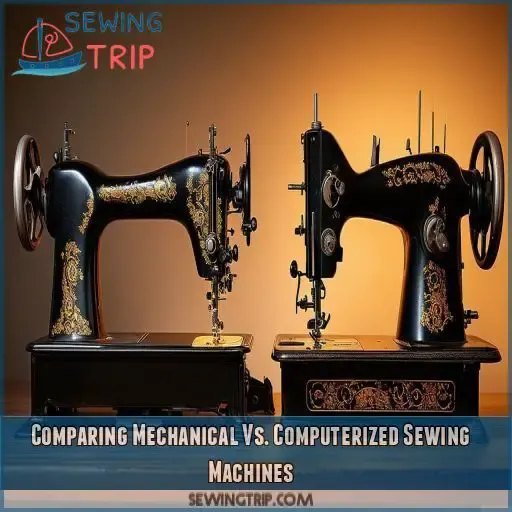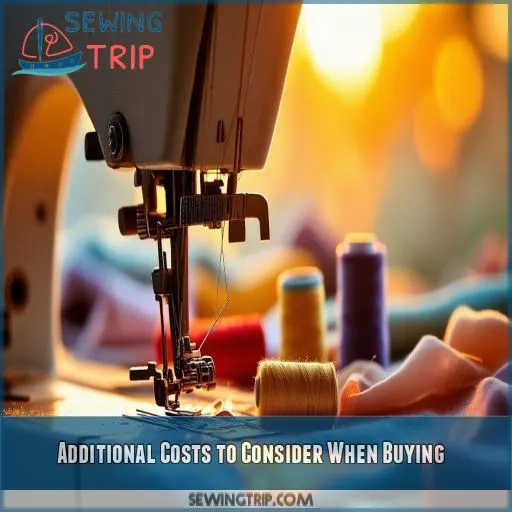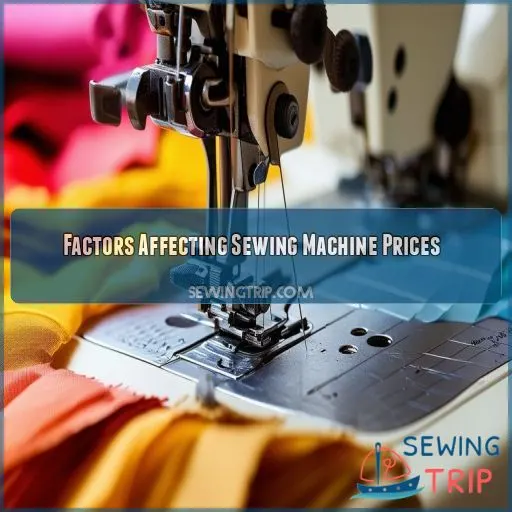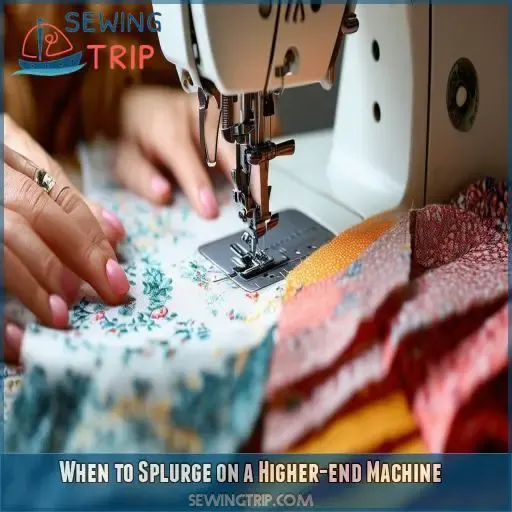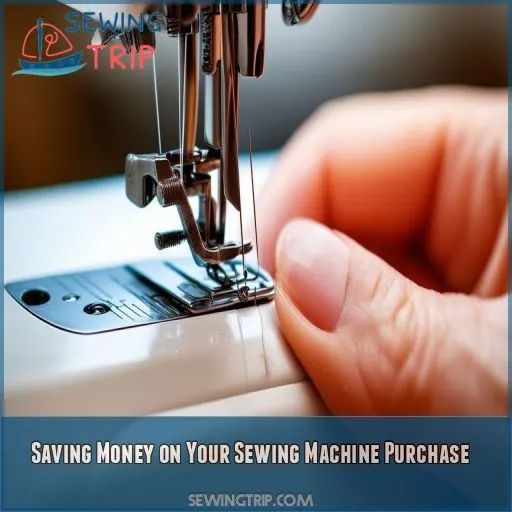This site is supported by our readers. We may earn a commission, at no cost to you, if you purchase through links.
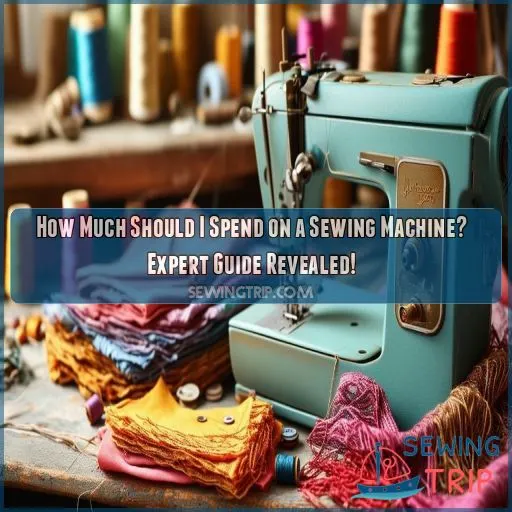
With prices ranging from budget-friendly to bank-breaking, it’s easy to feel overwhelmed.
But don’t worry – we’ve got this. This guide will help you figure out sewing machines, finding the perfect fit for your needs and budget.
Whether you’re a beginner or a seasoned pro, we’ll explore key factors to think about, from essential features to long-term value.
Get ready to stitch up some savings and find your ideal sewing companion!
Table Of Contents
- Key Takeaways
- How Much Should I Spend on a Sewing Machine?
- Determining Your Sewing Machine Budget
- Price Ranges for Different Sewing Machine Types
- Essential Features for Beginner Sewing Machines
- Investing in Quality: Durability and Longevity
- Comparing Mechanical Vs. Computerized Sewing Machines
- Additional Costs to Consider When Buying
- Factors Affecting Sewing Machine Prices
- When to Splurge on a Higher-end Machine
- Saving Money on Your Sewing Machine Purchase
- Frequently Asked Questions (FAQs)
- Conclusion
Key Takeaways
- Don’t break the bank on your first sewing machine! For beginners, $200-$350 will get you a trusty sidekick with all the essential features you need to start your sewing journey.
- Quality over quantity, folks! When it comes to stitches, more isn’t always merrier. Focus on the basics – straight, zigzag, and a few decorative options. You don’t need a machine that can embroider the Mona Lisa (unless that’s your thing, of course).
- Think of your sewing machine as a long-term relationship. With proper care and annual check-ups, these trusty companions can stick around for 20-25 years. That’s longer than some marriages!
- Don’t be afraid to shop the "gently used" rack! Refurbished machines can be a real gem in the rough, offering high-end features without the eye-watering price tag. Just make sure you’re buying from a reputable seller – you don’t want a lemon masquerading as a peach!
How Much Should I Spend on a Sewing Machine?
Wondering how much to spend on a sewing machine? Well, you’re not alone in this stitchy situation!
The sweet spot is typically between $100 and $2000, depending on your needs and budget.
If you’re just dipping your toes into the fabric world, a basic machine around $100-$300 will do the trick.
For the more seasoned sewers, you might want to splurge on a mid-range model ($300-$800) or even an advanced machine ($800-$2000).
Ready to unravel more sewing machine secrets?
Determining Your Sewing Machine Budget
Figuring out how much to spend on a sewing machine can feel like Threading a needle in the dark. But don’t worry – we’ll shed some light on this tricky topic and help you stitch together a budget that fits your needs and skills perfectly.
Assessing Your Sewing Needs and Goals
Ready to start sewing?
Let’s figure out what you want to make! Are you dreaming of trendy clothes, or maybe fixing up old things?
Maybe you’re thinking about making those awesome quilts you see on Pinterest?
Your sewing goals are what you’ll use to pick the perfect machine.
Don’t worry about spending a ton of money right away – we’ll find a machine that fits your budget and your creative ideas!
Considering Your Skill Level and Experience
How much you spend on a sewing machine really depends on your skills and experience.
If you’re just starting out, a basic machine won’t cost a fortune.
But if you’re a seasoned sewer with dreams of making quilts or embroidered masterpieces, you might need to spend a bit more.
Evaluating Your Financial Situation
- Take stock of your savings
- Review your monthly income and expenses
- Consider any upcoming financial goals
- Determine a comfortable spending limit
Balancing Cost With Features and Quality
Now that you’ve assessed your finances, it’s time to strike that sweet spot between cost, features, and quality. Think of it as a balancing act – you want a machine that won’t break the bank but still packs a punch. Let’s break it down with this handy table:
| Price Range | Features | Quality |
|---|---|---|
| $100-$300 | Basic | Good |
| $300-$600 | Standard | Better |
| $600-$1000 | Advanced | Best |
| $1000+ | Pro | Premium |
| Your Budget | Your Needs | Your Goal |
Price Ranges for Different Sewing Machine Types
Sewing machines come in all shapes and sizes, with options for every budget and skill level. Let’s explore the different price ranges, from budget-friendly entry-level models to high-end professional machines, so you can find the perfect fit for your sewing journey and wallet.
Entry-level Machines ($100-$300)
Now that you’ve assessed your needs, let’s take a look at entry-level machines.
These budget-friendly options, ranging from $100 to $300, are perfect for beginners or occasional sewers.
You’ll find basic models from reputable brands like Singer and Brother, offering essential features without breaking the bank.
While they may lack fancy bells and whistles, these machines can handle most simple projects and help you build your skills without a hefty investment.
Mid-range Machines ($300-$800)
Mid-range machines are the sweet spot for many sewers.
They offer a balance of quality and affordability, perfect for bringing your DIY dreams to life.
From quilting to clothing, they’ve got you covered.
Reliable brands in this range deliver stitch quality that’ll make your projects shine.
It’s like upgrading from a bicycle to a smooth-riding car!
Advanced Machines ($800-$2000)
Moving up to advanced machines, you’ll find a whole new world of sewing possibilities.
These beauties, priced between $800 and $2000, are like the Swiss Army knives of stitching.
They’re packed with features that’ll make your sewing dreams come true.
Think embroidery capabilities, hundreds of stitch options, and quilting-friendly designs.
While they might cost a pretty penny, these machines are worth their weight in gold for serious sewers and budding professionals.
Professional-grade Machines ($2000+)
Ready to take your sewing game to the next level? Professional-grade machines, priced at $2000+, are the crème de la crème of stitching wizardry. These powerhouses are built to handle anything you throw at them, from delicate silks to tough leathers. Here’s what makes them worth their weight in gold:
- Industrial-strength motors for lightning-fast stitching
- Unmatched durability for years of heavy use
- Advanced computerized features for precision work
- Specialized attachments for niche projects
Essential Features for Beginner Sewing Machines
When you’re starting your sewing journey, it’s really important to choose a machine with the right features. Let’s explore the must-have elements that’ll make your first stitches a breeze and set you up for sewing success.
Basic Stitch Options (straight, Zigzag, Buttonhole)
When shopping for your first sewing machine, don’t get tangled up in fancy features.
Focus on the bread and butter: straight, zigzag, and buttonhole stitches. These three will have you covered for most everyday projects and crafts.
A straight stitch is your workhorse, zigzag adds flexibility, and a one-step buttonhole will save you from button-related headaches.
Adjustable Stitch Length and Width
Now that you’ve got the basics covered, let’s talk about adjustable stitch length and width. This feature is like having a magic wand for your fabric! You’ll have the power to:
- Fine-tune your stitches for different fabrics
- Create decorative patterns with ease
- Adjust for thick or thin materials
- Customize your projects to your heart’s content
With this control, you’ll be sewing like a pro in no time, making your everyday dreams a reality!
Automatic Needle Threader
You’ll love an automatic needle threader – it’s a game-changer for your everyday sewing goals!
No more squinting and frustration; this nifty feature threads the needle for you in seconds.
It’s like having a tiny assistant that saves your eyes and patience.
Whether you’re a beginner or have decades of experience, this feature will make your sewing machine feel like your new best friend.
Free Arm Capability
You’ll love the free arm feature on your beginner sewing machine! It’s a game-changer for tackling small, circular projects. Just remove the accessory tray, and voila – you’ve got a narrow sewing space perfect for:
- Hemming sleeves without a fuss
- Conquering those tricky pant legs
- Adding professional touches to bags and pillowcases
- Mastering delicate cuffs and collars
Whether you’re whipping up curtains or crafting cozy blankets, this nifty feature will have you feeling like a sewing wizard in no time!
Reverse Stitch Function
You’ll love the reverse stitch function – it’s a game-changer for beginners!
This nifty feature lets you secure your stitches by sewing backwards, ensuring your creations don’t unravel.
Whether you’re whipping up home decor or crafting thoughtful gifts, the reverse stitch is your secret weapon.
It’s like putting a tiny lock on your seams, giving you the confidence to tackle everyday sewing projects with ease.
No more loose threads cramping your style!
Investing in Quality: Durability and Longevity
You get what you pay for when it comes to sewing machines. Investing in a quality machine with durable components and reliable performance can save you money and frustration in the long run, so let’s explore what makes a sewing machine built to last.
Metal Vs. Plastic Components
When you’re picking out a sewing machine, the insides matter.
Metal parts are the real workhorses, built to last through all the wear and tear.
Plastic might seem cheaper at first, but it’s not as reliable in the long run.
If you want a machine that’ll be there for you, go for metal parts.
It’s an investment in your sewing future!
Motor Strength and Stitching Speed
If you’re looking to crank up your sewing speed and power, a strong motor is your secret weapon!
It’s like having a trusty workhorse for all your sewing projects, whether you’re whipping up totes, purses, or wedding accessories.
Aim for machines that can handle 800-1000 stitches per minute.
This sweet spot gives you the muscle to tackle thick fabrics without a hitch, while still giving you the control you need for delicate projects.
Brand Reputation and Reliability
Sewing machines are more than just a pretty face – the brand matters! You wouldn’t trust your car to a shady mechanic, right? So why gamble on a no-name sewing machine? Stick with trusted brands that have a proven track record. They’re like the trusty old scissors in your sewing kit – reliable, durable, and always ready for your next creative project.
Warranty Coverage and Customer Support
When investing in a sewing machine, don’t overlook the warranty and customer support.
It’s like having a safety net for your creative journey. A solid warranty can be a lifesaver, protecting your investment and giving you peace of mind.
Look for machines with good coverage and responsive support teams. Remember, a reliable machine with great backup is worth its weight in gold-threaded bobbins!
Comparing Mechanical Vs. Computerized Sewing Machines
When choosing a sewing machine, you’ll encounter two main types: mechanical and computerized. Understanding the differences between these options can help you make an informed decision that fits your sewing needs and budget.
Cost Differences Between Mechanical and Computerized Models
When it comes to cost, mechanical and computerized sewing machines are like night and day. You’ll find mechanical models easier on your wallet, perfect for everyday peace. Computerized machines, though pricier, offer more bells and whistles for everyday success. Here’s a quick breakdown:
- Mechanical: $100-$400
- Computerized: $300-$1000+
- Hybrid models: $200-$600
Advantages and Disadvantages of Each Type
When choosing between mechanical and computerized sewing machines, it’s like deciding between a trusty old pickup truck and a shiny new sports car. Each has its perks and quirks! Let’s break it down in this handy table:
| Feature | Mechanical | Computerized |
|---|---|---|
| Price | Budget-friendly | Higher investment |
| Stitch options | Limited | Abundant |
| Learning curve | Straightforward | Steeper |
| Durability | Built like a tank | More delicate |
| Customization | Manual adjustments | Push-button ease |
Ease of Use and Maintenance Considerations
When it comes to ease of use and maintenance, mechanical and computerized machines each have their quirks.
Mechanical models are like trusty old cars – simple to operate and fix, but they might lack some modern conveniences.
Computerized machines, on the other hand, are your high-tech buddies, offering automatic features like needle threading.
However, they can be trickier to repair if something goes haywire.
Choose wisely for everyday contentment!
Suitability for Different Sewing Projects
When choosing between mechanical and computerized machines, consider your sewing projects. Each type shines in different areas:
- Mechanical: Great for simple projects and sturdy fabrics
- Computerized: Excels with delicate fabrics and intricate designs
- Both: Can handle basic sewing needs
Your fabric choices and project complexity will guide your decision. Remember, it’s not about having the fanciest machine, but the one that fits your sewing journey like a well-tailored glove!
Additional Costs to Consider When Buying
When you’re budgeting for a sewing machine, don’t forget about the hidden costs that can sneak up on you. From essential accessories to maintenance expenses, there’s more to think about than just the price tag on the machine itself.
Accessories and Attachments
When budgeting for your sewing machine, don’t forget about the accessories and attachments that’ll make your sewing journey a breeze. These extras can add up, but they’re worth their weight in gold. Let’s take a peek at some must-have add-ons:
| Accessory | Purpose |
|---|---|
| Presser feet | Specialized tasks like zippers |
| Bobbin case | Holds thread for lower stitching |
| Seam ripper | Undoing mistakes (we’ve all been there!) |
| Needles | Different types for various fabrics |
| Thread stand | Holds large spools for big projects |
Maintenance and Repair Expenses
While accessories are essential, don’t overlook the ongoing costs of keeping your sewing machine in tip-top shape.
Regular preventative maintenance is key to extending its life and avoiding costly repairs.
Set aside a little "sewing machine care fund" for annual tune-ups and potential part replacements.
Upgrade Potential and Future Needs
When buying a sewing machine, don’t forget to think about your future needs. You might outgrow a basic model faster than you think! Planning for the long-term can save you money and headaches down the road. Here’s what to keep in mind:
- Your sewing skills will improve, and you’ll crave more advanced features.
- Your projects might become more complex, requiring specialized functions.
- New technology could make your current machine feel outdated sooner than expected.
Sewing Classes or Instructional Materials
Don’t forget about learning the ropes!
While you’re eyeing that shiny new machine, consider setting aside some dough for sewing classes or instructional materials.
Whether you prefer online courses or local group lessons, investing in your skills is a smart move.
Think of it as the secret sauce to really make your sewing machine sing.
Plus, you’ll meet fellow fabric enthusiasts and maybe even find your sewing tribe!
Factors Affecting Sewing Machine Prices
When you’re shopping for a sewing machine, you’ll notice prices can vary wildly. Understanding the factors that influence these costs will help you make a smart choice that fits your needs and budget without breaking the bank.
Brand Name and Reputation
Brand name and reputation can really impact the price of a sewing machine. You’re not just paying for the machine; you’re investing in a company’s history, reliability, and customer support. Consider these factors:
- Brand longevity: Established brands often command higher prices because of their proven track record.
- Customer loyalty: Brands with devoted followings may charge a premium for their perceived value.
- Industry recognition: Award-winning or highly-rated brands typically come with a heftier price.
Number of Built-in Stitches and Functions
Sewing machines, more stitches don’t always equal a better deal.
Having a variety of built-in stitches can be tempting, but ask yourself: will you really use that fancy peacock embroidery?
Focus on the essentials – straight, zigzag, and a few decorative options.
Don’t let a high stitch count stitch up your wallet unnecessarily!
Advanced Features (embroidery, Quilting Capabilities)
Ready to level up your sewing game?
Advanced features like embroidery and quilting capabilities can really jazz up your projects, but they’ll also make your wallet sweat.
These fancy add-ons can send prices soaring faster than a speeding bobbin!
Think intricate patterns, automated designs, and specialized techniques at your fingertips.
But remember, with great power comes great responsibility (and a heftier price tag).
Is it worth it? That’s your stitch to pick!
Construction Quality and Materials Used
Sewing machines are all about quality. The way they’re built and the materials used can make a huge difference in how they sew. Don’t get caught up in fancy features; it’s what’s inside that counts. Metal parts usually last longer than plastic, so you get more for your money.
Here’s what to look for:
- Sturdy metal frame for stability
- High-quality metal gears for smooth operation
- Durable plastic casing that can take a beating
When to Splurge on a Higher-end Machine
While budget-friendly options can be great for beginners, there are times when investing in a higher-end sewing machine makes sense. If you’re a frequent sewer, have specialized needs like quilting or embroidery, or simply want to future-proof your purchase, splurging on a more advanced model might be worth considering.
Professional or Frequent Use
If you’re sewing for a living or burning through bobbins like there’s no tomorrow, it’s time to think about upgrading to a higher-end machine.
Your trusty starter model might be gasping for air under the workload!
A professional-grade machine isn’t just a purchase; it’s an investment in your craft.
It’ll handle heavy use with ease, saving you time and frustration in the long run.
Specialized Sewing Needs (quilting, Embroidery)
If you’re passionate about quilting or embroidery, investing in a higher-end machine might be your ticket to stitching bliss.
These specialized machines come with features that’ll make your projects sing – think larger throat space for quilts and built-in designs for embroidery.
Sure, they’re pricier, but imagine the joy of effortlessly creating intricate patterns without wrestling your fabric through a tiny hoop!
Long-term Investment Considerations
While specialized machines are great for quilting and embroidery, don’t forget to think long-term.
A higher-end machine isn’t just a purchase; it’s an investment in your sewing future.
You’re not just buying for today, but for years to come.
Consider the machine’s resale value and whether it’ll grow with your skills.
Desire for Advanced Features and Capabilities
If you’ve got a hunger for stitching wizardry, it might be time to splurge on a higher-end machine. Advanced features can turn your sewing game from "meh" to "wow!" Here’s why you might want to invest in those fancy bells and whistles:
- Embroidery capabilities that’ll make your grandma’s doilies jealous
- Quilting features smoother than butter on a hot biscuit
- Computerized precision that’ll have you feeling like a sewing superhero
Saving Money on Your Sewing Machine Purchase
You don’t have to break the bank to get a great sewing machine – there are plenty of ways to save money on your purchase. From shopping during sales to looking at refurbished models, we’ll show you how to snag a quality machine without emptying your wallet.
Shopping During Sales and Promotions
While splurging on a high-end machine can be tempting, savvy shoppers know that timing is everything.
Keep your eyes peeled for sales and promotions to snag a great deal.
Black Friday, Cyber Monday, and holiday seasons often bring juicy discounts.
Sign up for newsletters from sewing retailers to stay in the loop.
Considering Refurbished or Open-box Models
If you’re still hunting for deals, consider refurbished or open-box models. These gems can offer substantial savings without sacrificing quality. Here’s what to keep in mind:
- Research the seller’s reputation and return policy
- Compare warranties between refurbished and new models
- Inspect the machine thoroughly upon arrival
While there’s a slight risk, the reward of snagging a high-end machine at a fraction of the cost can be worth it. Just remember, trust your gut and don’t compromise on quality!
Negotiating Bundle Deals With Accessories
Ready to snag a sweet deal on your sewing machine?
Don’t be shy about negotiating bundle deals with accessories. Many retailers offer value packages that can save you a pretty penny.
Ask about thrown-in extras like presser feet, bobbins, or even a carrying case.
Be on the lookout for seasonal promotions, too.
Exploring Financing Options and Payment Plans
Don’t let a tight budget crush your sewing dreams!
Many retailers offer financing options that can turn that pricey machine into manageable monthly payments.
It’s like putting your new sewing companion on a layaway plan, minus the wait.
Just be sure to read the fine print and calculate the total cost.
Frequently Asked Questions (FAQs)
How much should a beginner spend on a sewing machine?
Ready to stitch your way to success? As a beginner, you’ll want to spend between $200 and $350 on your first sewing machine. This range offers quality and essential features without breaking the bank. You’ll be sewing up a storm in no time!
Do I really need an expensive sewing machine?
You don’t need to break the bank for a quality sewing machine. A mid-range model with essential features will serve you well. It’s like cooking – a fancy stove won’t make you a chef overnight!
What is the average lifespan of a sewing machine?
You’ll typically get 5-25 years out of your trusty sewing companion. With proper care, it’ll stick around longer than most relationships! Regular maintenance is key – treat it right, and it’ll keep stitching strong for decades.
How often should you replace a sewing machine?
A stitch in time saves nine," they say. You don’t need to replace your sewing machine often if you maintain it well. With regular care, a quality machine can last 20-25 years. Replace when repairs become frequent or costly.
How often should I service my sewing machine?
You’ll want to service your trusty sewing companion annually, or every 100 hours of use. Don’t wait for trouble to strike! Regular tune-ups keep your machine humming along smoothly, ensuring your creative projects don’t hit any snags.
Can I use industrial thread on a home sewing machine?
While you can use industrial thread on a home machine, it’s not always smooth sailing. You’ll need to adjust tension and use the right needle. Stick to home sewing thread for best results.
Whats the average lifespan of a sewing machine motor?
You’ll find that a well-maintained sewing machine motor typically lasts 20-25 years. Regular oiling and cleaning can extend its life, but don’t be surprised if it outlives your patience for that old-fashioned zigzag stitch!
Are refurbished sewing machines a good investment?
Penny wise, pound foolish? Not with refurbished sewing machines! You’ll save money without sacrificing quality. They’re often factory-restored with warranties. Just make sure you’re buying from a reputable seller. It’s a smart way to snag a great deal.
How do sewing machine warranties differ between brands?
You’ll find sewing machine warranties vary widely between brands. Some offer lifetime coverage on specific parts, while others provide limited-time warranties. It’s like comparing apples and oranges – always read the fine print before making your decision!
Conclusion
Deciding how much to spend on a sewing machine can feel like threading a needle in the dark!
But armed with this expert guide, you’re now ready to make a smart investment.
Whether you’re a beginner or a seasoned pro, focus on quality features that’ll grow with your skills.
Don’t be afraid to shop around, compare options, and ask questions.
Your ideal sewing companion is out there, waiting to help you stitch your dreams into reality!

